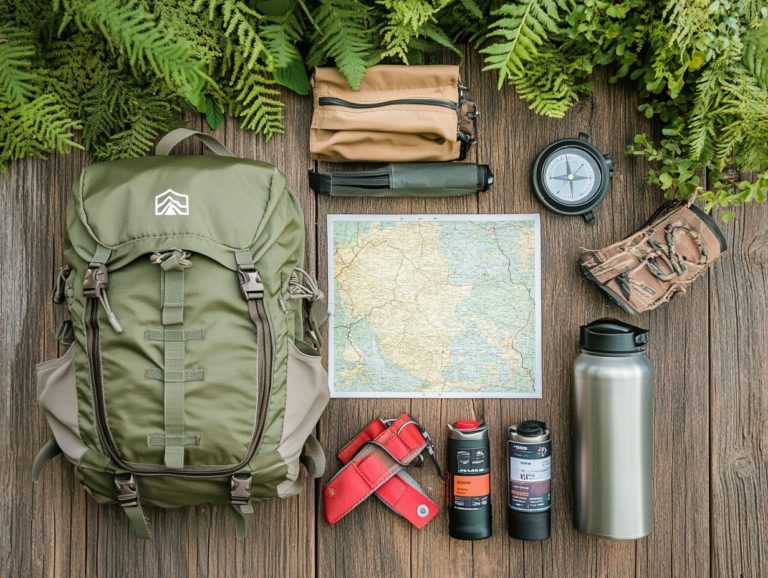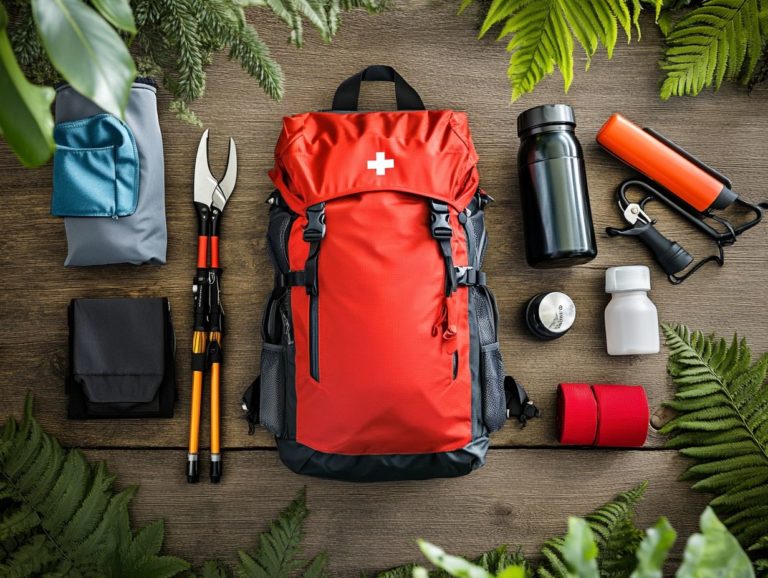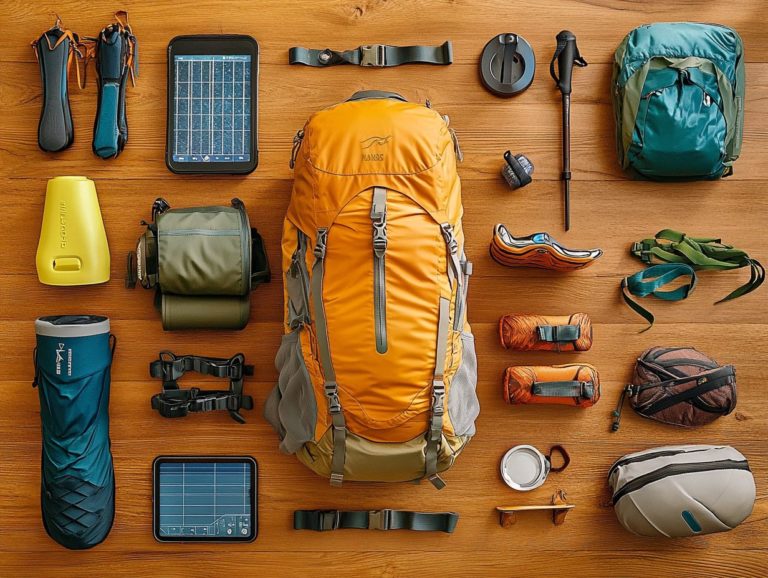The Importance of Sun Protection for Hikers
Hiking offers a wonderful opportunity to connect with nature, but it also harbors hidden dangers, particularly from sun exposure.
Whether you re setting out on a leisurely day hike or tackling a challenging multi-day backpacking journey, understanding the risks of UV rays is vital.
This article delves into the potential health risks linked to sun exposure, outlines the essential sun protection gear you should have, and shares practical tips for applying sunscreen effectively.
Discover how to stay safe and make the most of your outdoor adventures.
Contents
- Key Takeaways:
- Why Know About Sun Risks?
- The Dangers of Sun Exposure for Hikers
- The Basics of Sun Protection
- Stay Safe Under the Sun: Must-Have Gear for Hikers
- Tips for Applying and Reapplying Sunscreen
- Additional Measures for Sun Protection
- Importance of Sun Protection for Different Types of Hiking
- Frequently Asked Questions
- What are the dangers of not using sun protection while hiking?
- What are the most important sun protection measures for hikers?
- Don’t forget to reapply your sunscreen while hiking here’s why!
- How can I protect myself from the sun’s rays while hiking at high altitudes?
- What are some signs of heat exhaustion while hiking?
- Why is sun protection important even on cloudy days while hiking?
Key Takeaways:
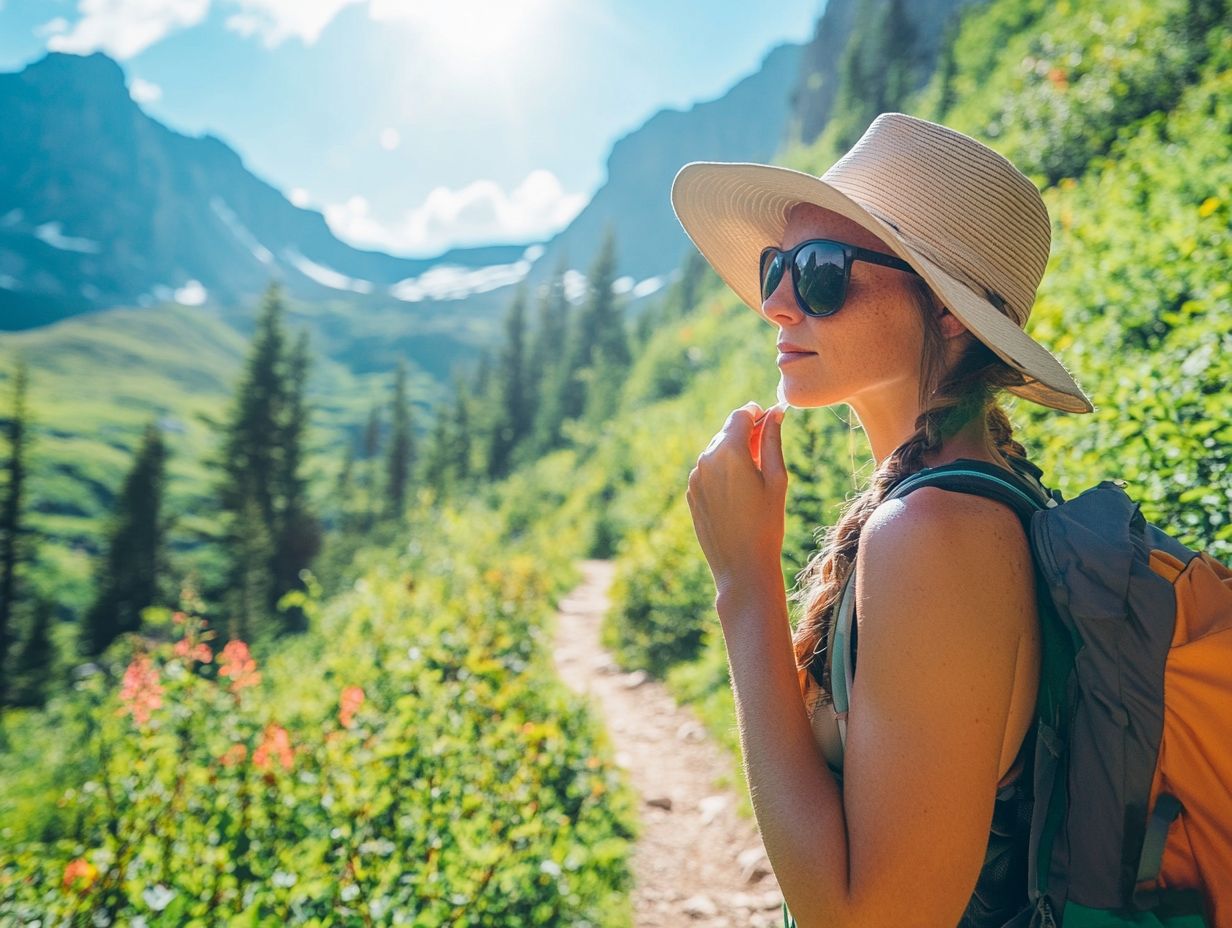
- Protecting your skin from the sun is crucial for hikers, as prolonged exposure can lead to serious health risks, including skin cancer.
- Understanding SPF and UV rays can help hikers choose the right sun protection and defend against harmful sun damage.
- Essential gear like sunscreen, sunglasses, and hats are must-haves for any hiker to ensure proper sun protection on and off the trails.
Why Know About Sun Risks?
The Dangers of Sun Exposure for Hikers
Hikers frequently overlook the perils of sun exposure, which can lead to significant skin damage and elevate the risk of skin cancer over time.
As you traverse diverse terrains, the likelihood of encountering harmful UV rays increases, particularly during peak intensity hours.
This exposure not only jeopardizes your skin health but can also lead to long-term repercussions if you don t take necessary precautions. Knowing these risks helps you enjoy hiking without worry!
Potential Health Risks
The potential health risks linked to prolonged sun exposure during your hiking adventures are significant, including skin cancer, premature aging, and various forms of skin damage.
Outdoor enthusiasts often underestimate the cumulative effects of UV radiation, which can lead to issues like sunburn, photoaging, and, in severe cases, melanoma.
Statistics highlight that those who spend considerable time in the sun especially hikers face an elevated risk of developing skin cancer. In fact, reports indicate that one in five Americans will receive a skin cancer diagnosis at some point in their lives.
To effectively mitigate these risks, using sunscreen regularly greatly reduces your chances of sunburn and subsequent skin damage, providing crucial protection against long-term effects while you relish the beauty of the great outdoors.
The Basics of Sun Protection
Understanding the fundamentals of sun protection is crucial for hikers eager to relish their adventures without compromising their skin health.
Effective sun protection entails mastering the proper application of sunscreen, grasping the importance of SPF ratings, and recognizing the potential harm UV rays pose to the skin.
It’s equally important to be aware of the various types of sunscreen, including water-resistant options, to guarantee comprehensive protection during your journey.
By integrating sun protection into your hiking gear, you can safeguard your skin health and avert long-term damage, ensuring every trek is as enjoyable as it is safe.
Understanding SPF and UV Rays
SPF, or Sun Protection Factor, tells you how long you can stay in the sun without burning compared to wearing no sunscreen and is crucial for hikers with sensitive skin.
Understanding SPF is essential for effective sun protection, especially since UV rays fall into two main categories: UVA and UVB.
UVA rays penetrate deeply into the skin, contributing to premature aging and increasing the risk of skin cancer, while UVB rays are primarily the culprits behind sunburn.
When choosing the right SPF level, consider factors like your skin tone, activity level, and the intensity of your sun exposure.
If you’re gearing up for outdoor activities like hiking, opting for a higher SPF ideally 30 or greater is a smart move. This ensures broad-spectrum protection against both types of UV rays and considers the varying vulnerability of different skin tones to sun damage.
As you prepare for your next hike, remember to apply these sun protection tips to keep your skin safe and enjoy your time outdoors!
Stay Safe Under the Sun: Must-Have Gear for Hikers
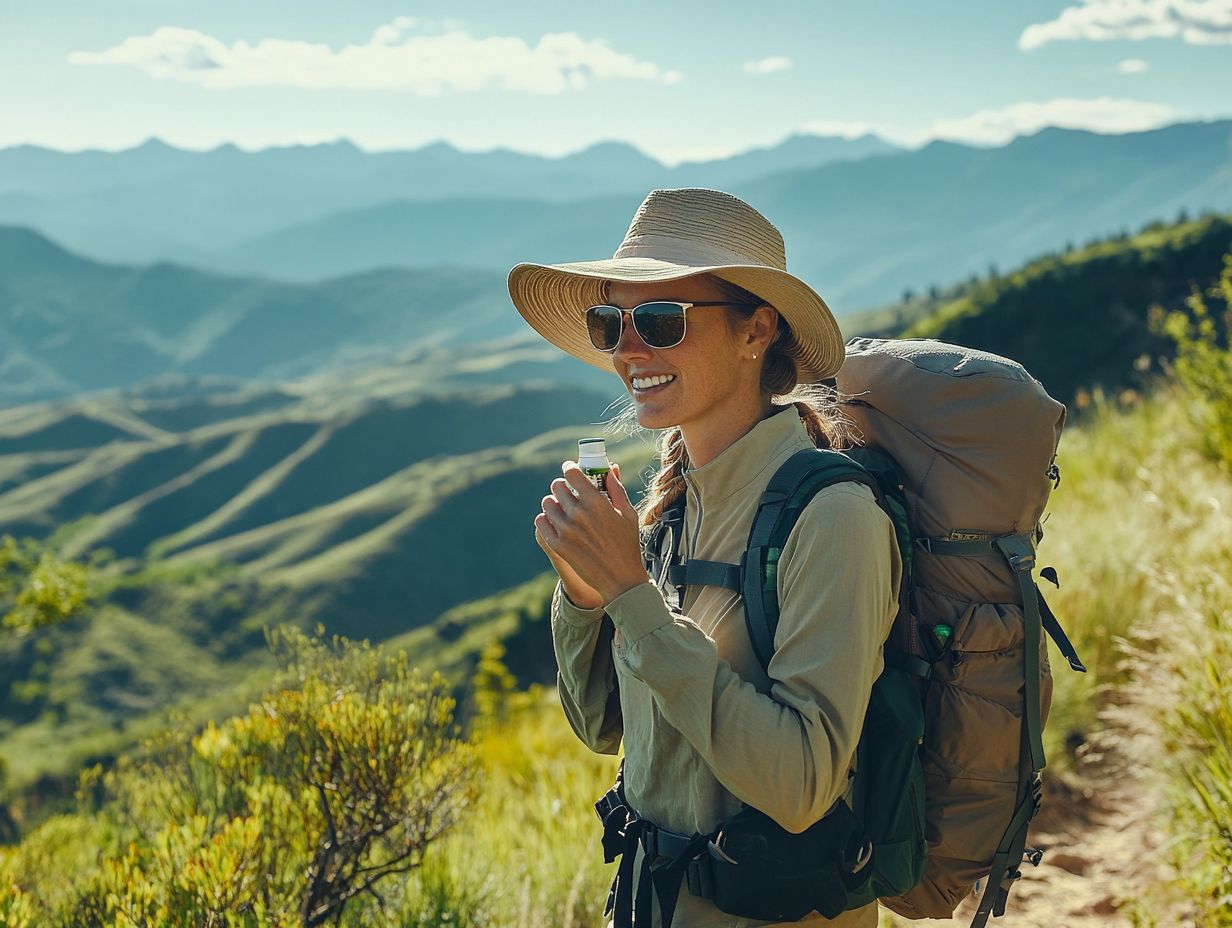
For those who love to hike, possessing the right sun protection gear is a necessity. This includes long-sleeved shirts and packable hats to shield yourself from harmful UV rays during your outdoor adventures.
Key items include:
- High-SPF sunscreen
- Wide-brimmed hats
- Polarized sunglasses
- UV-blocking clothing
These items help minimize your skin’s exposure. Opt for moisture-wicking fabrics and lightweight attire to keep you comfortable on the trail while offering essential protection against the sun’s damaging effects. Investing in quality hiking gear that prioritizes sun safety is crucial for preserving your skin’s health during extended adventures.
Sunscreen, Sunglasses, and Hats
Sunscreen, sunglasses, and wide-brimmed hats are must-have items for your sun protection kit! They ensure you re shielded from harmful UV rays and allow for a more enjoyable adventure.
Choose a broad-spectrum sunscreen with at least SPF 30, which protects against both UVA and UVB rays. Popular brands like Neutrogena and Banana Boat are trusted companions for outdoor enthusiasts.
Polarized sunglasses minimize glare from sunlit surfaces, enhancing your visibility and comfort on the trails. Brands like Oakley and Maui Jim offer great options that combine style and functionality.
Don t overlook wide-brimmed hats they re crucial for protecting your face and neck. Look for durable and breathable designs from Columbia or Outdoor Research.
Together, these essentials not only provide vital protection but also ensure your hiking experience is enjoyable and memorable, especially considering the environmental impact of your gear choices.
Tips for Applying and Reapplying Sunscreen
Applying and reapplying sunscreen correctly is essential for protecting your skin from harmful UV rays during your hiking adventures. It’s best to apply broad-spectrum sunscreen at least 15 minutes before stepping into the sun. Pay special attention to areas like your face, neck, and any exposed skin.
Remember to reapply every two hours or immediately after swimming or sweating. This helps maintain peak protection and enhances your skin’s resilience during your outdoor activities.
Proper Techniques and Frequency
Proper techniques and the right frequency for applying sunscreen are essential for maximum protection against the sun’s harmful rays.
To achieve optimal defense, apply a generous amount about a full ounce, roughly the size of a shot glass covering all exposed skin. Don t forget often overlooked spots like your ears, neck, and the back of your hands.
Spread the sunscreen evenly using circular motions for consistent coverage. Reapplication is key; refreshing every two hours is recommended, or even more frequently if you re sweating or swimming.
Staying hydrated is also important for maintaining your skin’s health. Proper hydration strengthens your skin’s barrier and enhances its resilience against sun damage, especially during those long hikes.
Additional Measures for Sun Protection
Along with applying sunscreen, seek shade and stay well-hydrated to enhance your sun protection while hiking. By incorporating these practices, you can fully enjoy your outdoor adventures with a sense of responsibility and care for your well-being.
Seeking Shade and Staying Hydrated
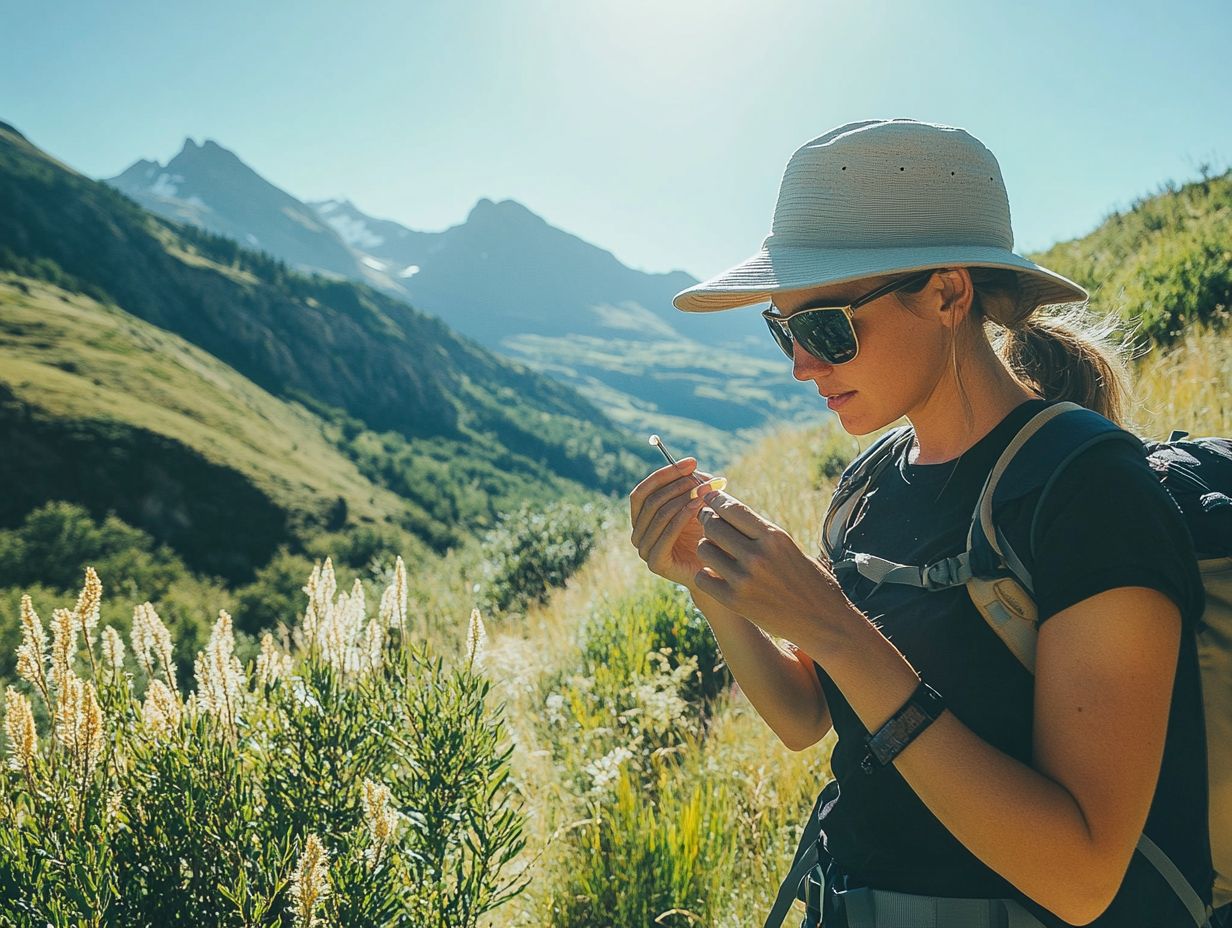
Seeking shade and staying hydrated can significantly enhance your comfort during hiking trips while minimizing sun exposure and preventing sunburn.
Look for natural or man-made shade to effectively shield yourself from the sun s intense rays. This greatly reduces the risk of heat exhaustion and sunburn.
Drink plenty of fluids! Maintaining proper hydration levels is vital for your overall well-being in hot conditions. Drinking fluids goes hand in hand with using sunscreen and wearing protective clothes, creating a comprehensive approach to sun protection.
These measures not only protect your skin health but also help maintain your energy levels, ensuring a more enjoyable and safer experience in the great outdoors.
Importance of Sun Protection for Different Types of Hiking
The significance of sun protection changes dramatically depending on the type of hiking you undertake, whether it s a leisurely day hike or an extensive multi-day backpacking journey. Each demands its own strategic approach to sun safety.
For day hikers, the duration of sun exposure is generally shorter, allowing for the use of lightweight sunscreen and protective gear. Conversely, those embarking on multi-day trips face extended exposure, necessitating a more robust sun protection strategy.
By recognizing these distinctions, you can better safeguard your skin health and prevent sun damage from UV rays, which are harmful rays from the sun that can damage your skin. This ensures your outdoor adventures remain enjoyable and safe.
Day Hikes vs. Multi-Day Backpacking Trips
When you compare day hikes to multi-day backpacking trips, your strategies for sun protection need to adapt to the duration and intensity of sun exposure and the UV protection factor.
For a single-day adventure, where the sun s intensity is often less daunting, a high-quality sunscreen with at least high SPF should do the trick.
However, for those longer excursions that stretch over several days, think about the cumulative effects of UV radiation and the higher altitudes that can amplify sun exposure.
Your gear selection becomes critical here! Wide-brimmed hats, UV-blocking clothing, and top-notch sunglasses are essential companions for extended trips.
Don t overlook proper hydration tips, either dehydrated skin is definitely more prone to damage.
Planning ahead by considering your hiking environment, whether it’s an open desert trail or a shaded forest, can greatly influence how effective your sun protection will be throughout your journey. Using UV-blocking clothing and sun hats can make a huge difference, especially when you understand the importance of UV protection in outdoor clothing!
Frequently Asked Questions
What are the dangers of not using sun protection while hiking?
Not using sun protection while hiking can lead to serious health risks, including sunburn, heat exhaustion, dehydration, and even skin cancer, particularly from overexposure to UV rays.
What are the most important sun protection measures for hikers?

The most important sun protection measures for hikers include wearing water-resistant sunscreen with a high SPF, covering exposed skin with lightweight clothing, and wearing a hat and sunglasses to protect your face and eyes.
Don’t forget to reapply your sunscreen while hiking here’s why!
Reapplying sunscreen while hiking is crucial because it can wear off from sweat and rubbing against clothing, leaving your skin vulnerable to the sun’s harmful rays.
How can I protect myself from the sun’s rays while hiking at high altitudes?
At high altitudes, the sun’s rays are stronger and can cause more damage to the skin. It’s important to use a water-resistant sunscreen and wear UV protective fabrics to shield yourself from the sun’s intensity.
What are some signs of heat exhaustion while hiking?
Signs of heat exhaustion while hiking include dizziness, nausea, headache, and excessive sweating. If you’re feeling faint, seek shade and drink plenty of water immediately to prevent heat stroke.
Why is sun protection important even on cloudy days while hiking?
The sun’s harmful rays can reach your skin, even on cloudy days. Keep chemical-free sunscreen handy and apply it regularly to protect your skin, no matter the weather!

